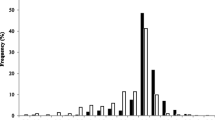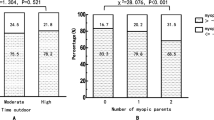Abstract
Purpose
To investigate the influence of daily activities on myopic refractive change and myopic onset in Chinese urban students.
Methods
The Beijing Myopia Progression Study was a 3-year cohort study. Cycloplegic refraction and a daily activity questionnaire were assessed at baseline and at follow-up examinations. Refractive change was defined as the difference in cycloplegic spherical equivalent (SE) between the final follow-up and baseline. 386 students were initially enrolled in the baseline study.
Results
At the final follow-up, 222 students (57.5 %) with completed refractive error and daily activity data were analyzed. These students spent 0.32 ± 2.33 h/day more on near work (p = 0.04), and 0.21 ± 1.31 h/day less on outdoor leisure (p = 0.02), than they did at baseline. In the multivariate analysis, the younger among the secondary students (β = 0.06, p < 0.001), and those with more near work hours at baseline (β = −0.028, p = 0.033), exhibited more myopic refractive change. However, myopic refractive change was not found to be significantly associated with near work hours in the primary students, or with time spent outdoors, in either school level. After stratifying the activity hours into quartile groups, students with a greater near work load at baseline (trend P = 0.03) exhibited a greater myopic refractive change and had a higher risk to develop myopia (hazard ratio, 95 % confidence interval: 5.19, 1.49–18.13), after adjusting for the confounders. However, no significant association was found related to outdoor activity.
Conclusions
In this cohort, children with a greater near work load at baseline exhibited more myopic refractive change and were also more likely to develop myopia. The protective effect of outdoor activity on myopic refractive change was not observed.

Similar content being viewed by others
References
Zhao J, Pan X, Sui R, Munoz SR, Sperduto RD, Ellwein LB (2000) Refractive error study in children: results from Shunyi District, China. Am J Ophthalmol 129:427–435
He M, Zeng J, Liu Y, Xu J, Pokharel GP, Ellwein LB (2004) Refractive error and visual impairment in urban children in southern China. Invest Ophthalmol Vis Sci 45:793–799
He M, Huang W, Zheng Y, Huang L, Ellwein LB (2007) Refractive error and visual impairment in school children in rural southern China. Ophthalmology 114:374–382. doi:10.1016/j.ophtha.2006.08.020
Lam CS, Goldschmidt E, Edwards MH (2004) Prevalence of myopia in local and international schools in Hong Kong. Optom Vis Sci 81:317–322
Saw SM, Tong L, Chua WH, Chia KS, Koh D, Tan DT, Katz J (2005) Incidence and progression of myopia in Singaporean school children. Invest Ophthalmol Vis Sci 46:51–57. doi:10.1167/iovs.04-0565
Lim HT, Yoon JS, Hwang SS, Lee SY (2012) Prevalence and associated sociodemographic factors of myopia in Korean children: the 2005 third Korea National Health and Nutrition Examination Survey (KNHANES III). Jpn J Ophthalmol 56:76–81. doi:10.1007/s10384-011-0090-7
Liang YB, Lin Z, Vasudevan B, Jhanji V, Young A, Gao TY, Rong SS, Wang NL, Ciuffreda KJ (2013) Generational difference of refractive error in the baseline study of the Beijing Myopia progression study. Br J Ophthalmol 97:765–769. doi:10.1136/bjophthalmol-2012-302468
Lin Z, Gao TY, Vasudevan B, Jhanji V, Ciuffreda KJ, Zhang P, Li L, Mao GY, Wang NL, Liang YB (2014) Generational difference of refractive error and risk factors in the Handan offspring myopia study. Invest Ophthalmol Vis Sci 55:5711–5717. doi:10.1167/iovs.13-13693
Wu PC, Tsai CL, Wu HL, Yang YH, Kuo HK (2013) Outdoor activity during class recess reduces myopia onset and progression in school children. Ophthalmology 120:1080–1085. doi:10.1016/j.ophtha.2012.11.009
Lin Z, Vasudevan B, Jhanji V, Mao GY, Gao TY, Wang FH, Rong SS, Ciuffreda KJ, Liang YB (2014) Near work, outdoor activity, and their association with refractive error. Optom Vis Sci 91:376–382. doi:10.1097/opx.0000000000000219
Parssinen O, Lyyra AL (1993) Myopia and myopic progression among schoolchildren: a 3-years follow-up study. Invest Ophthalmol Vis Sci 34:2794–2802
Kinge B, Midelfart A, Jacobsen G, Rystad J (2000) The influence of near-work on development of myopia among university students. A 3-years longitudinal study among engineering students in Norway. Acta Ophthalmol Scand 78:26–29
Hepsen IF, Evereklioglu C, Bayramlar H (2001) The effect of reading and near-work on the development of myopia in emmetropic boys: a prospective, controlled, 3-years follow-up study. Vis Res 41:2511–2520
Jacobsen N, Jensen H, Goldschmidt E (2008) Does the level of physical activity in university students influence development and progression of myopia? A 2-years prospective cohort study. Invest Ophthalmol Vis Sci 49:1322–1327. doi:10.1167/iovs.07-1144
French AN, Morgan IG, Mitchell P, Rose KA (2013) Risk factors for incident myopia in Australian schoolchildren: the Sydney adolescent vascular and eye study. Ophthalmology 120:2100–2108. doi:10.1016/j.ophtha.2013.02.035
Guo Y, Liu LJ, Xu L, Tang P, Lv YY, Feng Y, Meng M, Jonas JB (2013) Myopic shift and outdoor activity among primary school children: 1-year follow-up study in Beijing. PLoS One 8:e75260. doi:10.1371/journal.pone.0075260
Lin Z, Vasudevan B, Liang YB, Zhang YC, Qiao LY, Rong SS, Li SZ, Wang NL, Ciuffreda KJ (2012) Baseline characteristics of nearwork-induced transient myopia. Optom Vis Sci 89:1725–1733. doi:10.1097/OPX.0b013e3182775e05
Liang YB, Wong TY, Sun LP, Tao QS, Wang JJ, Yang XH, Xiong Y, Wang NL, Friedman DS (2009) Refractive errors in a rural Chinese adult population the Handan eye study. Ophthalmology 116:2119–2127. doi:10.1016/j.ophtha.2009.04.040
Mutti DO, Mitchell GL, Moeschberger ML, Jones LA, Zadnik K (2002) Parental myopia, near work, school achievement, and children’s refractive error. Invest Ophthalmol Vis Sci 43:3633–3640
Saw SM, Shankar A, Tan SB, Taylor H, Tan DT, Stone RA, Wong TY (2006) A cohort study of incident myopia in Singaporean children. Invest Ophthalmol Vis Sci 47:1839–1844. doi:10.1167/iovs.05-1081
Jones LA, Sinnott LT, Mutti DO, Mitchell GL, Moeschberger ML, Zadnik K (2007) Parental history of myopia, sports and outdoor activities, and future myopia. Invest Ophthalmol Vis Sci 48:3524–3532. doi:10.1167/iovs.06-1118
Saw SM, Tan SB, Fung D, Chia KS, Koh D, Tan DT, Stone RA (2004) IQ and the association with myopia in children. Invest Ophthalmol Vis Sci 45:2943–2948. doi:10.1167/iovs.03-129645/9/2943
Mandel Y, Grotto I, El-Yaniv R, Belkin M, Israeli E, Polat U, Bartov E (2008) Season of birth, natural light, and myopia. Ophthalmology 115:686–692. doi:10.1016/j.ophtha.2007.05.040
Guggenheim JA, Northstone K, McMahon G, Ness AR, Deere K, Mattocks C, Pourcain BS, Williams C (2012) Time outdoors and physical activity as predictors of incident myopia in childhood: a prospective cohort study. Invest Ophthalmol Vis Sci 53:2856–2865. doi:10.1167/iovs.11-9091
Jin JX, Hua WJ, Jiang X, Wu XY, Yang JW, Gao GP, Fang Y, Pei CL, Wang S, Zhang JZ, Tao LM, Tao FB (2015) Effect of outdoor activity on myopia onset and progression in school-aged children in northeast China: the Sujiatun eye care study. BMC Ophthalmol 15:73. doi:10.1186/s12886-015-0052-9
He M, Xiang F, Zeng Y, Mai J, Chen Q, Zhang J, Smith W, Rose K, Morgan IG (2015) Effect of time spent outdoors at school on the development of myopia among children in china: a randomized clinical trial. JAMA 314:1142–1148. doi:10.1001/jama.2015.10803
Jones-Jordan LA, Sinnott LT, Cotter SA, Kleinstein RN, Manny RE, Mutti DO, Twelker JD, Zadnik K (2012) Time outdoors, visual activity, and myopia progression in juvenile-onset myopes. Invest Ophthalmol Vis Sci 53:7169–7175. doi:10.1167/iovs.11-8336
Guo Y, Liu LJ, Xu L, Lv YY, Tang P, Feng Y, Meng M, Jonas JB (2013) Outdoor activity and myopia among primary students in rural and urban regions of Beijing. Ophthalmology 120:277–283. doi:10.1016/j.ophtha.2012.07.086
French AN, Morgan IG, Burlutsky G, Mitchell P, Rose KA (2013) Prevalence and 5- to 6-years incidence and progression of myopia and hyperopia in Australian school children. Ophthalmology 120:1482–1491. doi:10.1016/j.ophtha.2012.12.018
Acknowledgments
The authors thank Dr. Xiao Gu Cai (Beijing Tongren Hospital, Capital Medical University), Dr. Yi Cao Zhang (Anyang Eye Hospital), Dr. Xiao Dong Yang (Nanjing Tongren Hospital), Dr. Qian Jia (Handan Eye Hospital), and Dr. Yue Wu (Beijing Xuanwu Hospital, Capital Medical University) for their invaluable assistance in data collection.
Author information
Authors and Affiliations
Corresponding author
Ethics declarations
Competing interests
All authors certify that they have no affiliations with or involvement in any organization or entity with any financial interest, or non-financial interest in the subject matter or materials discussed in this manuscript.
Funding
The Innovation Research Project of the Eye Hospital of Wenzhou Medical University (YNCX201308), the Research Startup Project for Doctors of the Eye Hospital of Wenzhou Medical University (KYQD131101), the Research Startup Project of Wenzhou Medical University (89213008), and the Beijing Science & Technology Novel Star Program (2009B44), provided the financial support. The sponsor had no role in the design or conduct of this research.
Ethical approval
All procedures performed in studies involving human participants were in accordance with the ethical standards of the institutional and/or national research committee and with the 1964 Helsinki Declaration and its later amendments or comparable ethical standards.
Informed consent
Informed consent was obtained from all individual participants included in the study.
Rights and permissions
About this article
Cite this article
Lin, Z., Vasudevan, B., Mao, G.Y. et al. The influence of near work on myopic refractive change in urban students in Beijing: a three-year follow-up report. Graefes Arch Clin Exp Ophthalmol 254, 2247–2255 (2016). https://doi.org/10.1007/s00417-016-3440-9
Received:
Revised:
Accepted:
Published:
Issue Date:
DOI: https://doi.org/10.1007/s00417-016-3440-9




